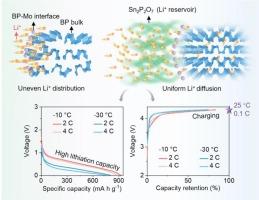使用高容量磷基阳极的低温快速充电锂离子电池
IF 22
1区 材料科学
Q1 MATERIALS SCIENCE, MULTIDISCIPLINARY
引用次数: 0
摘要
低温下的高可靠性快速充电对于锂离子电池的发展至关重要。尽管磷基阳极具有安全的锂化电位和较高的理论容量,但其Li+转移的减少导致容量利用率降低和结构变化。我们报道了一种具有低温快速充电能力的黑磷基阳极。该设计将BP-Mo颗粒与Sn2P2O7结合,Sn2P2O7是一种活性Li+储层,促进Li+快速均匀扩散,并诱导稳定的li3p基固电解质界面。高质量负载的BP-Mo/Sn2P2O7阳极在- 10°C和4°C条件下的容量为5.6 mA h cm - 2和751 mA h g - 1,在- 30°C和2C条件下的容量为4.9 mA h cm - 2和691 mA h g - 1,循环300次后容量分别保持79%和75%。在- 50°C下,175次循环后,616 mA h g - 1的初始容量保持92%。在这两种条件下,BP-Mo/Sn2P2O7与licoo2阴极的完整电池在低温下表现出相当稳定的快速充电能力,在- 10°C和2C循环150次后,袋状电池的容量保持率为88%。本文章由计算机程序翻译,如有差异,请以英文原文为准。

Fast-charging lithium-ion batteries at low temperatures using a high-capacity phosphorus-based anode
Highly reliable fast-charging at low temperatures is critical for the advancement of lithium-ion batteries. Despite the safe lithiation potential and high theoretical capacity of a phosphorus-based anode, its decreased Li+ transfer leads to reduced capacity utilization and structural variations. We report a black phosphorus (BP)-based anode with fast-charging ability at low temperatures. The design involves BP-Mo particles incorporated with Sn2P2O7, an active Li+ reservoir, facilitating fast and uniform Li+ diffusion and inducing stable Li3P-based solid-electrolyte interphase. The high-mass loaded BP-Mo/Sn2P2O7 anode delivers a capacity of 5.6 mA h cm−2 and 751 mA h g−1 at −10°C and 4C, and 4.9 mA h cm−2 and 691 mA h g−1 at −30 °C and 2C, with 79 % and 75 % capacity retention after 300 cycles, respectively. At −50°C, the initial capacity of 616 mA h g−1 retains 92 % after 175 cycles. Under these two conditions, the full cells of BP-Mo/Sn2P2O7 paired with LiCoO2cathode show comparable stable fast-charging ability at low temperatures, and the pouch cell has a capacity retention of 88 % at −10 °C and 2C after 150 cycles.
求助全文
通过发布文献求助,成功后即可免费获取论文全文。
去求助
来源期刊

Materials Today
工程技术-材料科学:综合
CiteScore
36.30
自引率
1.20%
发文量
237
审稿时长
23 days
期刊介绍:
Materials Today is the leading journal in the Materials Today family, focusing on the latest and most impactful work in the materials science community. With a reputation for excellence in news and reviews, the journal has now expanded its coverage to include original research and aims to be at the forefront of the field.
We welcome comprehensive articles, short communications, and review articles from established leaders in the rapidly evolving fields of materials science and related disciplines. We strive to provide authors with rigorous peer review, fast publication, and maximum exposure for their work. While we only accept the most significant manuscripts, our speedy evaluation process ensures that there are no unnecessary publication delays.
 求助内容:
求助内容: 应助结果提醒方式:
应助结果提醒方式:


